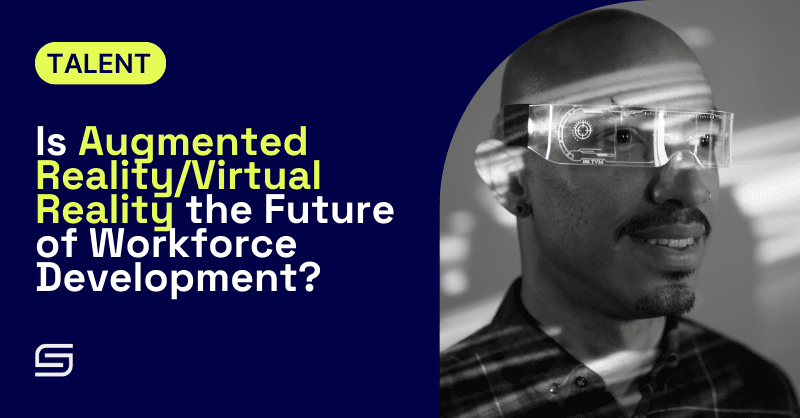Is Augmented Reality/Virtual Reality the Future of Workforce Development?

This post originally appeared on Robert’s LinkedIn.
Augmented reality (AR) and virtual reality (VR), or AR/VR technologies, have moved beyond gaming and entertainment.
They’re becoming essential tools in workforce development, offering scalable and cost-effective ways to train employees.
As businesses increasingly focus on developing skills at scale, immersive technologies can drive workforce productivity, retention, and efficiency.
Incorporating immersive training through AR/VR allows companies to deliver complex training modules that feel real but come without the associated risks.
This is especially crucial in industries like healthcare, manufacturing, and data centers, where hands-on experience is critical but costly and risky to provide in the real world.
The ability to simulate environments, machinery, or human interactions within virtual spaces enables employees to learn by doing, resulting in more effective and safer skill development.
What is AR/VR?
Augmented Reality (AR) and Virtual Reality (VR) are immersive technologies designed to enhance or simulate real-life experiences. AR overlays digital elements onto the physical world through devices like smartphones or AR glasses, enriching what we see and interact with in real time. This is often used for on-the-job guidance or task support, adding a layer of helpful digital information without fully replacing the surrounding environment.
VR, on the other hand, creates a completely virtual environment using headsets, immersing users in a simulated space where they can practice tasks, explore scenarios, or interact with objects as if they were real.
Together, AR and VR provide new, effective tools for workforce training by offering hands-on experiences that traditional learning methods can’t match.
The Role of Immersive Training in Workforce Development
AR/VR technologies have found a significant role in corporate learning and workforce development, providing solutions that can scale across industries. The benefits include:
- Realistic Simulations: Employees can interact with virtual equipment, spaces, or even co-workers, allowing them to gain hands-on experience in safe, controlled environments. For example, data center technicians can practice troubleshooting complex machinery without the risk of damaging expensive equipment
- Personalized Learning: Immersive technology supports adaptive learning environments, where training modules adjust to everyone’s learning speed and needs. AI integration can further tailor the training experience, offering real-time feedback and adjustments
- Cost Efficiency: Traditional training methods, such as physical classrooms and materials, require substantial investment. VR eliminates the need for physical training setups, allowing employees to access training modules from anywhere, making learning more flexible
These immersive solutions are transforming how companies approach skills-based hiring and workforce development.
Smoothstack’s Approach to Workforce Development
Smoothstack’s Hire-Train-Deploy model is designed to accelerate talent development, helping enterprises overcome hiring bottlenecks and skills gaps by offering custom training cohorts.
This model has increasingly integrated VR training for technical roles where hands-on experience is crucial.
For example, within data centers, Smoothstack uses VR to simulate complex equipment troubleshooting.
Engineers can train on virtual equipment, making mistakes and learning from them without real-world consequences. This approach speeds up the training process and increases retention by offering practical, repeatable experiences.
Incorporating AR/VR into training aligns with workforce trends that emphasize skills-based hiring and continual upskilling. The immersive technology allows enterprises to create custom training paths that are both scalable and adaptable, crucial for industries that require rapid skill development at scale.
Why Enterprises Should Consider AR/VR in Workforce Development
- Scalability: Immersive technology allows companies to scale training efforts across locations, removing logistical barriers. Employees in different geographies can undergo the same high-quality training without needing to be physically present in the same place.
- Improved Productivity: By simulating complex tasks, employees can learn faster and with fewer errors. VR-based training has shown to significantly reduce error rates and increase productivity once employees transition to real-world tasks.
- Engagement and Retention: AR and VR provide an interactive learning experience that keeps employees engaged. The hands-on nature of VR ensures that learners are fully immersed, reducing distractions common in traditional learning environments.
- Flexible Learning Environments: With AR and VR, companies can offer training that fits different learning styles, whether visual, auditory, or kinesthetic. This versatility ensures that training programs meet the diverse needs of a global workforce.
The Future of Workforce Development
As AR/VR technologies evolve, their applications in workforce development will expand.
The potential to integrate real-time AI feedback, adaptive learning modules, and even gamified simulations will further enhance training experiences. Companies that embrace these technologies now will be better equipped to navigate the future workforce’s demands.
Smoothstack’s custom training solutions already leverage VR to accelerate technical skill development, positioning companies for success in a competitive labor market.
By focusing on tailored, immersive learning environments, enterprises can enhance employee productivity, reduce costs, and build resilient, scalable workforces.
AR/VR in workforce development aren’t just trends—they are critical tools for building the workforce of tomorrow.
As the workplace becomes more dynamic and complex, immersive technologies offer a competitive edge that companies can’t afford to overlook.
Let’s Build Your Team
Connect with the Smoothstack team to learn how to close your digital skills gap with a custom-trained team.